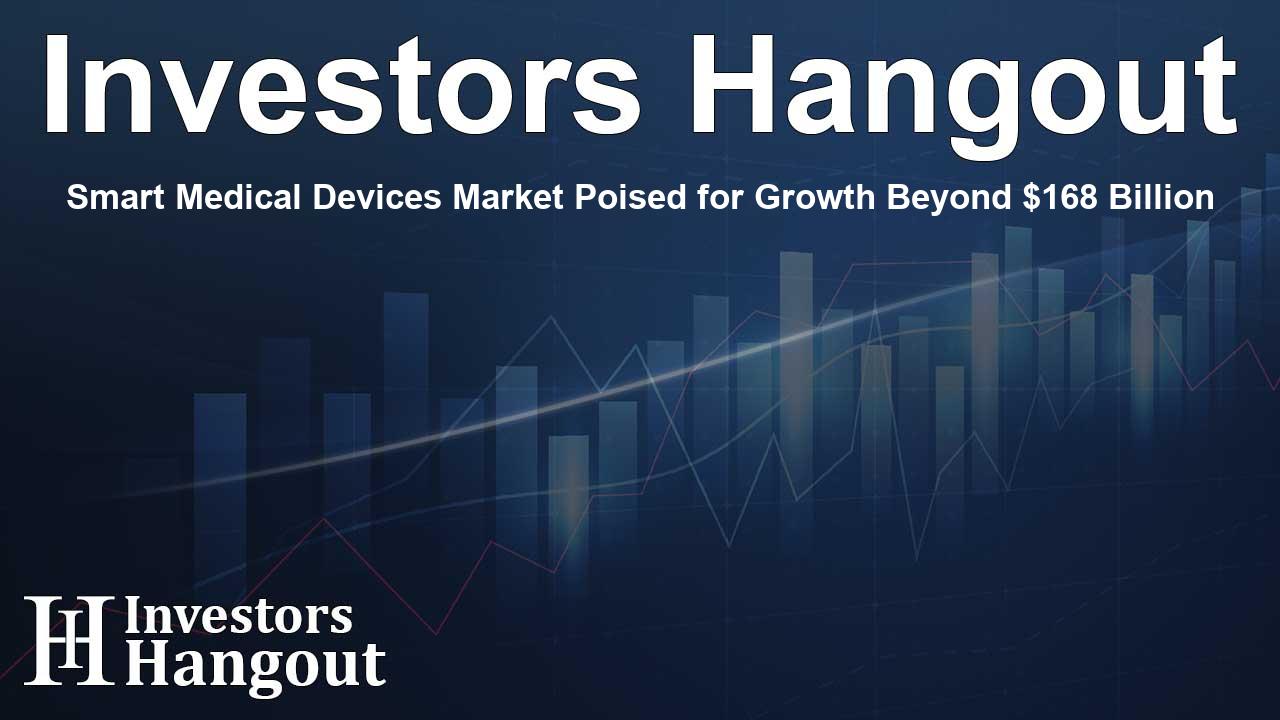Smart Medical Devices Market Poised for Growth Beyond $168 Billion

Smart Medical Devices Market Overview and Future Projections
Recent insights into the smart medical devices market indicate a significant growth trajectory. Anticipated to escalate from USD 59.26 billion in the near future to over USD 168 billion by the year 2034, this market reflects a compound annual growth rate (CAGR) of an impressive 12.30% from the current assessment to the future, driven largely by rising health concerns and increased focus on home healthcare.
Market Drivers and Dynamics
The growth of the smart medical devices market is primarily powered by the increasing prevalence of chronic diseases, heightened awareness of health management, and consumer demand for accessible healthcare solutions. As healthcare shifts towards preventive care, the integration of technology in medical devices is becoming crucial.
Smart medical devices leverage advanced technologies like the Internet of Things (IoT) and artificial intelligence (AI) to enhance patient care. These devices enable real-time health monitoring, data collection, and personalized treatment plans, aiming for improved patient outcomes through better management of health conditions.
Understanding Smart Medical Devices
Smart medical devices are defined as internet-connected instruments that analyze and collect critical health data. These include various tools embedded with sensors, real-time monitoring capabilities, and wireless connectivity. Such devices not only improve the efficiency of healthcare services but also promote greater self-care among patients. The benefits include personalized treatments, ease of healthcare management, and greater access to necessary services, especially in home care settings.
Geographical Trends and Market Segmentation
In North America, the market holds the largest share, attributed to a well-established healthcare infrastructure and rapid adoption of digital health technologies. Meanwhile, the Asia Pacific region shows the fastest growth, driven by increased disease prevalence and investments in healthcare technologies.
Among various segments, the diagnostics and monitoring category leads with a remarkable 87% share of the market, reflective of the urgent need for chronic disease monitoring tools. Home care settings also represent a significant area of growth, paralleling societal shifts towards more personalized health management strategies.
Government Initiatives Supporting Smart Medical Devices
Governments around the world are investing in healthcare innovations that support the development of smart medical devices. These initiatives range from simplifying the process of acquiring medical devices to bolstering funding aimed at advancing medical technologies.
For instance, various government efforts focus on promoting the use of AI in healthcare and launching portable diagnostic tools, reinforcing the shift towards more accessible and effective patient care.
The Rise of Remote Patient Monitoring
Remote patient monitoring (RPM) has emerged as a top trend in the market, allowing patients to manage their health from home. This trend caters to the increasing need for chronic disease management solutions and a growing elderly population. As more smart devices become available to facilitate everyday health monitoring, patient compliance and engagement improve significantly.
Challenges Facing the Market
Despite its potential, the smart medical devices market faces challenges, particularly concerning the high costs associated with development and compliance with stringent regulatory standards. The requirement for sophisticated technologies and rigorous testing can create additional barriers to entry for new products. However, as technology advances and production methods improve, these challenges may diminish over time.
Main Competitors in the Market Space
Leading companies like Abbott, Dexcom, Apple, and Fitbit play pivotal roles in shaping the smart medical device landscape. These organizations invest heavily in research and development, driving innovation and enhancing the effectiveness of devices.
Furthermore, partnerships and collaborations within the sector contribute to the rapid deployment of cutting-edge technologies, ultimately benefiting consumers seeking improved health management tools.
Frequently Asked Questions
What is the current size of the smart medical devices market?
The smart medical devices market size is currently estimated at USD 59.26 billion and is expected to exceed USD 168 billion by 2034.
What factors are driving growth in this market?
Key drivers include an increasing prevalence of chronic diseases, rising health awareness, and a focus on home healthcare solutions.
Which region holds the largest share of the market?
North America currently accounts for the largest market share due to its advanced healthcare infrastructure and strong presence of leading technology companies.
What are the main segments of smart medical devices?
The primary segments include diagnostics and monitoring devices, therapeutics, and wearable technology, with diagnostics leading the market.
What challenges does the smart medical device market face?
Challenges include high development costs, complex regulatory requirements, and the need for extensive testing and quality assurance.
About The Author
Contact Caleb Price privately here. Or send an email with ATTN: Caleb Price as the subject to contact@investorshangout.com.
About Investors Hangout
Investors Hangout is a leading online stock forum for financial discussion and learning, offering a wide range of free tools and resources. It draws in traders of all levels, who exchange market knowledge, investigate trading tactics, and keep an eye on industry developments in real time. Featuring financial articles, stock message boards, quotes, charts, company profiles, and live news updates. Through cooperative learning and a wealth of informational resources, it helps users from novices creating their first portfolios to experts honing their techniques. Join Investors Hangout today: https://investorshangout.com/
The content of this article is based on factual, publicly available information and does not represent legal, financial, or investment advice. Investors Hangout does not offer financial advice, and the author is not a licensed financial advisor. Consult a qualified advisor before making any financial or investment decisions based on this article. This article should not be considered advice to purchase, sell, or hold any securities or other investments. If any of the material provided here is inaccurate, please contact us for corrections.
